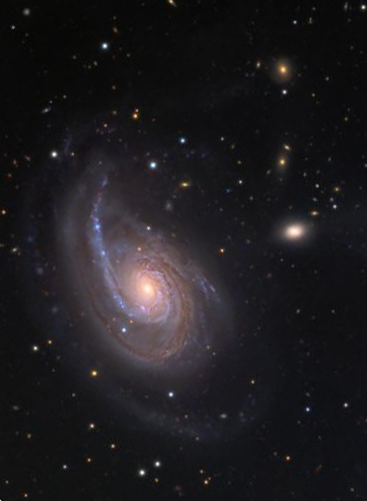
Arp 78, also known as NGC 772, was originally listed in Halton Arp’s Atlas of Peculiar Galaxies because of its possible interaction with nearby high redshift companions via its extensive and diffuse spiral arms. Its redshift is listed in NED as z = 0.008246. This places the galaxy at a distance of 115 million light years using a so-called Hubble Constant value of 70 (km/s)/Mpc.
The image on the right is from the University of Arizona’s Mt. Lemmon SkyCenter. It has been rotated and cropped to match the orientation of the original image used by Dr. Arp in his atlas. The bright object on the right is the likely true companion NGC 770. In a straight line above NGC 770 are two small yellow objects which are the high redshift companions in question. In addition to their distinct color compared to NGC 772 and NGC 770, their size and morphology indicate that they are most likely not companions after all but distant background galaxies.
Modern observations may have clarified two possible redshift discordancies in NGC 772 but they have also revealed a new and more compelling one! In the late 1980’s a quasar labeled [HB89] 0156+187 was discovered near the galactic core of NGC 772. The exact location of this quasar along with two observed supernovae is shown in the image below generated using the free Aladin interactive sky atlas software. The light green square marks the QSO.
![NGC 772 and [HB89] 0156+187 NGC 772 and [HB89] 0156+187](http://discordancy.report/wp-content/uploads/2012/10/aladin_overlay_cropped_ngc772.png)
Close examination of even the highest resolution images available reveal little more than bright knots of gas and stars in this inner most region of the galaxy’s spiral arms. It is difficult to believe that any background object could be visible through the density of stellar material present in this location near the center of the galaxy. Yet continued spectral analysis of [HB89] 0156+187 into the early 21st century indicates a redshift of z = 2.61 which would supposedly place it far behind NGC 772 at a distance of well over 11 billion light years!
Obviously, as with most of the examples I have posted to this site, there is a need for higher resolution observations and closer examination of the objects presented. If it were not for the extremely high redshift of [HB89] 0156+187 it would be easy to assume by most scientists that the object was located either within or in front of the inner spiral arms of NGC 772, based on the data available today. Better observations may clarify the actual position of this quasar and place it in the background as in the case of the previously described companion objects observed by Arp. However, what will scientists do if better observations reveal that the quasar is indeed part of NGC 772? Will they finally be forced to reexamine the true nature of extragalactic redshifts and the validity of universal expansion? Either way it is important that research be continued and questions continue to be asked, regardless of whether or not we like the answers that result.
Shannon



 UGC 892 and its companion 2MASXI J0121174-003312 were first listed as Arp 67 in
UGC 892 and its companion 2MASXI J0121174-003312 were first listed as Arp 67 in  One would think that such a discrepancy would garner a closer look by one of the several larger telescopes that have been built since the Hale in the past sixty years. Yet the only other observations I could find of Arp 67 were even lower resolution images produced by one-meter range telescopes such as the
One would think that such a discrepancy would garner a closer look by one of the several larger telescopes that have been built since the Hale in the past sixty years. Yet the only other observations I could find of Arp 67 were even lower resolution images produced by one-meter range telescopes such as the  NED lists the redshift of the larger galaxy at 0.034377 z which would place its distance at over 595 million light-years from Earth using a so-called
NED lists the redshift of the larger galaxy at 0.034377 z which would place its distance at over 595 million light-years from Earth using a so-called  Although the photograph is somewhat grainy it is quite apparent that there is a smaller galaxy immediately adjacent to the main galaxy at its southern end. It also appears quite possible that these two objects are physically connected. However, if they are physically connected then how to account for their vastly discordant redshifts? The redshift of the larger galaxy at 0.00587 z would place its distance at approximately 104 million light-years from Earth using a so-called
Although the photograph is somewhat grainy it is quite apparent that there is a smaller galaxy immediately adjacent to the main galaxy at its southern end. It also appears quite possible that these two objects are physically connected. However, if they are physically connected then how to account for their vastly discordant redshifts? The redshift of the larger galaxy at 0.00587 z would place its distance at approximately 104 million light-years from Earth using a so-called